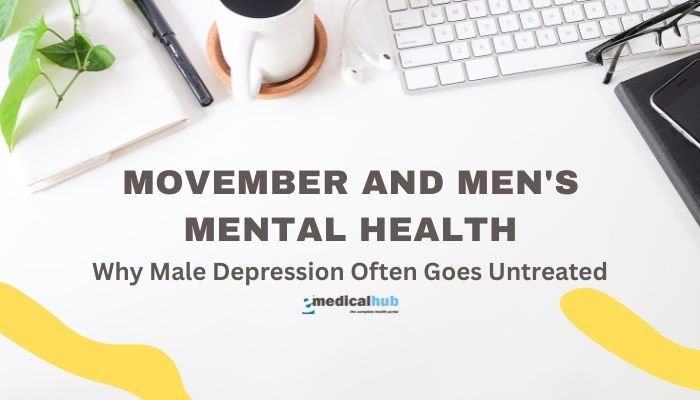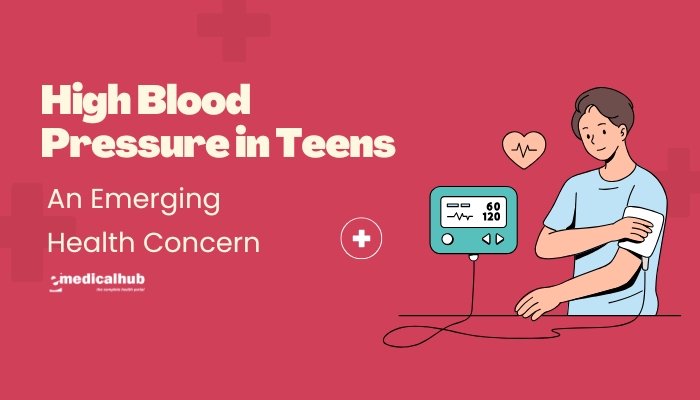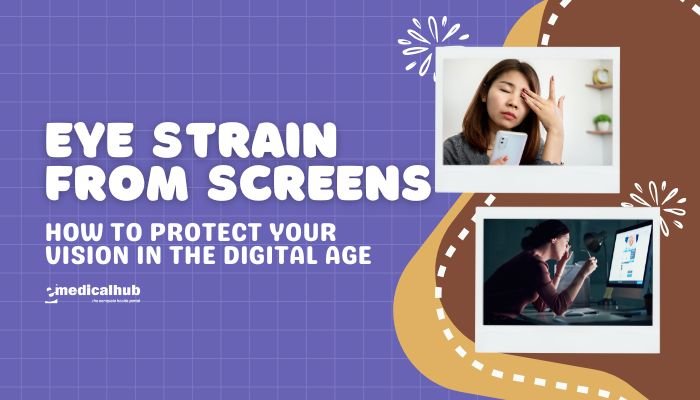Introduction
Each November, men worldwide grow mustaches to promote “Movember,” a global movement aiming to raise awareness and funds for men’s health issues – from prostate and testicular cancer to mental health and suicide prevention.
Amid the mustachioed fundraising and camaraderie, Movember spotlights a critical yet sometimes overlooked area of men’s health: psychological well-being. Although both men and women experience mental health challenges, male depression often goes undiagnosed or untreated due to stigma, cultural expectations of masculinity, and the tendency for men to minimize or hide emotional struggles.
This article explores the complexities behind male depression, examining why men are less likely to seek help, and how Movember’s emphasis on men’s mental health can foster a cultural shift toward openness and support.
By understanding the societal, biological, and individual contributors to male depression, men and their communities can better recognize symptoms, dismantle barriers to care, and connect men with resources that promote lasting emotional resilience.
Understanding Male Depression
What Is Depression?
- Clinical Definition: Depression is a mood disorder marked by persistent sadness, loss of interest in activities, changes in appetite or sleep, low energy, and sometimes suicidal thoughts.
- Variations: Depressive episodes can range from mild to severe, influencing daily functioning and overall quality of life.
- Men’s Experience: In men, depression may manifest in specific ways – such as anger, irritability, or risk-taking, contrasting with classic sadness or tearfulness.
Prevalence and Gender Disparities
- Global Statistics: Depression affects over 264 million people worldwide. While women are statistically diagnosed more often, suicide rates are higher among men, suggesting underdiagnosis or subclinical presentations.
- Subtle Signs: Men may “mask” depression with substance use, escapist behaviors (like workaholism), or aggression, fueling the belief that depression is rarer in men.
Key Differences in Male Depression
- Symptom Expression: Men sometimes exhibit depression through physical complaints (e.g., headaches, digestive problems), emotional numbness, or angry outbursts rather than open sadness.
- Stigma and Socialization: Traditional masculinity norms discourage men from admitting vulnerability, so they might “act out” instead of seeking help.
- Risky Coping Mechanisms: Substance misuse, reckless driving, or gambling can reflect underlying distress in men who find it difficult to verbalize emotional pain.
Takeaway: Recognizing the unique face of male depression is crucial for early intervention, bridging the gap between men’s internal struggles and professional or social support.
Why Male Depression Often Goes Untreated
Cultural Norms of Masculinity
- “Tough It Out” Mentality: Societal narratives telling boys and men to “man up” or not show “weakness” can lead them to suppress feelings, ignoring or denying mental health issues.
- Stoicism: Pride in self-reliance discourages men from confiding in loved ones or seeking therapy, intensifying isolation.
- Fear of Judgment: Concern about how colleagues, partners, or family perceive a man who admits mental distress can deter open conversations about depression.
Lack of Awareness and Recognition
- Overlooking Symptoms: Men may be less attuned to emotional states or fail to identify them as depression. Healthcare providers might also misread irritability or aggression as personality traits rather than signs of depression.
- Fewer Screenings: Women often interface more with healthcare systems (e.g., for reproductive health), leading to earlier detection of emotional issues. Men might skip routine checkups or mention stress only if forced.
Structural Barriers to Care
- Accessibility: Busy schedules or remote living conditions can impede therapy visits.
- Financial Concerns: Health insurance may not fully cover mental health sessions; some men prioritize family finances over personal well-being.
- Employer Attitudes: Fear of workplace repercussions or negative performance judgments can discourage men from using mental health leave or disclosing their depression.
Societal Misinformation
- Perception That Men Don’t Get Depressed: Stereotypical beliefs may hamper recognition.
- Limited Public Dialogue: Even though Movember and other campaigns shine a light, stigma remains in many communities, limiting men’s willingness to discuss or learn about depression.
The Role of Movember in Men’s Mental Health
What Is Movember?
- Origins: Began in Australia (2003), encouraging men to grow mustaches each November for cancer awareness. It soon broadened to men’s overall health, especially mental health and suicide prevention.
- Global Reach: Movember Foundation campaigns in numerous countries, mobilizing communities, workplaces, and celebrities to spark conversation and fundraising.
- Funds and Awareness: A portion of raised funds supports mental health initiatives, research, and community-based programs.
Movember’s Mental Health Initiatives
- Encouraging Conversations: By wearing a mustache, participants spark dialogue about men’s well-being, breaking the silence.
- Project Funding: Partnerships with local organizations that provide counseling, crisis hotlines, or resilience training tailored to men.
- Online Resources: Tools or campaigns offering tips on checking in on male friends (e.g., the “ALEC” model: Ask, Listen, Encourage action, Check in), normalizing mental health talk.
Impact and Ongoing Challenges
- Increased Visibility: Globally recognized mustache movement fosters a sense of collective purpose in men’s health.
- Still, Stigma Persists: Despite progress, men in certain cultures or contexts remain reluctant to seek help. More targeted, sustained efforts year-round are needed.
Recognizing Depression in Men: Signs and Symptoms
Emotional and Behavioral Indicators
- Irritability: Quick anger, frustration over small stressors.
- Increased Risk-Taking: Gambling, driving recklessly, or excessive alcohol usage.
- Withdrawal: Reduced interest in social events or hobbies.
- Fatigue or Low Energy: Chronic exhaustion unrelated to physical exertion.
- Loss of Pleasure: Hobbies, sex, or enjoyable activities no longer bring satisfaction.
Physical Complaints
- Somatic Symptoms: Stomach issues, headaches, or pain without clear medical cause may mask underlying depression.
- Sleep Changes: Insomnia or oversleeping.
- Appetite Changes: Overeating “comfort foods” or reduced appetite.
Thoughts or Speech Patterns
- Hopelessness: Expressing negative self-view, futility about the future.
- Self-Criticism: Belief of being a “failure,” letting others down.
- Suicidal Ideation: Even fleeting suicidal thoughts should trigger immediate professional intervention.
Approaches to Treating Male Depression
Psychotherapy
Cognitive Behavioral Therapy (CBT)
- Core Concept: Restructures negative thought patterns to reduce depressive symptoms. Helps men discover more adaptive coping.
- Tailoring for Men: Focusing on problem-solving, practical steps resonates with men’s preference for actionable solutions.
Interpersonal Therapy (IPT)
- Relationships Focus: Addresses how relationships and social roles affect mood. Emphasizes communication skills.
- Men’s Engagement: Those with interpersonal conflict might find IPT beneficial, bridging emotional expression with structured skill development.
Group Therapy or Peer Support
- Sense of Shared Experience: Men can realize they aren’t alone in confronting depression.
- Peer Mentorship: Building role models who overcame depression can empower reluctant individuals to open up.
Medications
Antidepressants
- SSRIs (Selective Serotonin Reuptake Inhibitors): E.g., sertraline, fluoxetine, citalopram – first-line for moderate to severe depression.
- SNRIs, Atypical Antidepressants: Other classes for men who fail SSRIs or need a different side effect profile.
- Timeframe: 4–6 weeks to note improvements in mood; side effects (sexual dysfunction, GI issues) can deter male compliance.
Augmentation Strategies
- Add-On Therapy: If partial response, psychiatrists might add second agents (e.g., buspirone, bupropion) or refine dosage.
- Hormonal Factors: If low testosterone coexists, addressing it might improve depression synergy.
Lifestyle Interventions
- Exercise: Aerobic workouts can be as potent as mild antidepressants in alleviating mood issues, supporting self-esteem, and boosting brain-derived neurotrophic factor (BDNF).
- Nutrition: Balanced diets, including whole grains, lean protein, fruits, vegetables, Omega-3s (e.g., fish), show positive correlations with improved mood.
- Stress Management: Techniques like mindfulness, meditation, yoga help men handle underlying anxiety or tension fueling depression.
Social and Community Resources
- Support Networks: Encouragement from friends, family, or men’s support groups fosters accountability in continuing therapy.
- Workplace Programs: Employee assistance programs or mental health days can reduce stigma in professional environments.
- Telehealth: Virtual therapy and mental health apps provide discrete, convenient counseling sessions—particularly beneficial if men fear judgment.
Severe Cases
- Hospitalization: For men at serious risk of self-harm or those severely impaired, inpatient care ensures safety and round-the-clock support.
- Electroconvulsive Therapy (ECT): A solution for treatment-resistant or life-threatening depression. Though stigmatized, it can be highly effective for some.
Encouraging Men to Seek Help: Overcoming Barriers
Communication Strategies
- Normalize Emotional Struggles: Using language that resonates with men’s preference for practical solutions can be more effective (“stress management” or “mental fitness” vs. “emotional therapy”).
- Emphasize Confidentiality: Assuring men of privacy may alleviate fear about disclosing vulnerabilities.
Role of Partners and Family
- Observing Behavioral Changes: Loved ones might notice shifts in mood or routine; gentle encouragement to see a professional can break inertia.
- Providing Non-Judgmental Space: Listening without pressuring, offering help with booking appointments, or accompanying them if requested.
Workplace and Organizational Support
- Employee Assistance Programs: Anonymous hotlines or counseling offerings.
- Men’s Health Initiatives: Movember or internal “mental wellness” campaigns can quell stigma, highlight success stories, and signpost resources.
The Power of Peer Testimony
- Public Figures: Sports icons or celebrities discussing their mental health experiences can shift cultural norms, showing that strength includes vulnerability.
- Social Media Movements: Hashtags (#MensMentalHealth) and grassroots stories facilitate broader acceptance of men’s emotional challenges.
Movember Campaigns: Practical Steps and Impact
Fundraising and Awareness
- Growing a Mustache: Serves as a conversation starter, letting supporters direct dialogues about men’s mental health.
- Events and Challenges: Walk/runs, corporate fundraisers, or social gatherings unify men (and women) to rally around improved mental and physical health.
Education Outreach
- Webinars, Workshops: Movember organizations or affiliates often sponsor open forums about depression signs, coping strategies, and local resources.
- Barbershop Initiatives: Partnerships with barbers, who often serve as informal counselors for men, teaching them how to broach mental health topics.
Larger Social Movement
- Cultural Shift: Movember underscores that mental health is integral, just as addressing prostate cancer is. Advocating for “real conversations” among men.
- Year-Round Effects: Even though the campaign peaks in November, the momentum fosters ongoing dialogues, bridging men’s health with robust philanthropic networks.
Long-Term Outlook and Future Directions
Stigma Reduction
- Generational Changes: Younger men may be more open to therapy, benefiting from expansions in telemedicine and mental health apps.
- Ongoing Campaigns: Sustained marketing and re-education about how common depression is in men, and that seeking help is a courageous choice.
Integrative Care
- Holistic Health: Collaboration among general practitioners, psychologists, psychiatrists, and men’s health specialists ensures seamless management of physical and mental health.
- Personalized Medicine: Genetic or biomarker-based approaches to diagnosing and tailoring antidepressants may enhance efficacy.
Technological Innovations
- Apps and Digital Therapy: Self-guided CBT programs, mobile trackers, or AI-based mental health screening tools.
- Virtual Reality Treatments: Emerging, albeit experimental, with potential to reduce social anxiety and deliver interactive therapy experiences.
Movember’s Expanding Mission
- Global Growth: More countries participating, more fundraising for mental health projects.
- Community Hubs: The creation of local mentorship or men’s mental health clubs fosters real-life connections beyond mustache campaigns.
Conclusion
Male depression remains underdiagnosed and undertreated, frequently obscured by cultural expectations of stoicism and emotional self-sufficiency. Movember’s annual focus on men’s mental health offers a crucial nudge toward open dialogue and acceptance, empowering men to seek the care they need without shame. Recognizing that male depression can manifest through irritability, risk-taking, or physical complaints is key for timely intervention.
Effective treatment can integrate psychotherapy, medication, lifestyle changes, and robust social support systems. Men who embrace therapy or medication often find significant relief from chronic low mood, regaining emotional vitality and life engagement. Furthermore, adopting a healthy diet, routine exercise, and stress management helps maintain stable mental health over time. By continuing to build safe spaces and broadening the men’s mental health conversation, society can ensure that men no longer feel compelled to hide depression, leading to healthier, happier lives for themselves and their loved ones.
References
- World Health Organization. Depression and Other Common Mental Disorders: Global Health Estimates. Geneva: WHO; 2017.
- https://movember.com/
- Addis ME, Mahalik JR. Men, masculinity, and the contexts of help seeking. Am Psychol. 2003;58(1):5-14.
- Seidler ZE, Dawes AJ, Rice SM, et al. The role of masculinity in men’s help-seeking for depression: A systematic review. Clin Psychol Rev. 2016;49:106-118.
- American Psychological Association. Recognizing Depression in Men. 2021.
- American Psychiatric Association. Diagnostic and Statistical Manual of Mental Disorders (DSM-5). 5th ed. Washington, DC: APA; 2013.
- Chekroud SR, Gueorguieva R, Zheutlin AB, et al. Association between physical exercise and mental health in 1.2 million individuals in the USA. Lancet Psychiatry. 2018;5(9):739-746.
- Hull TD, Rofey DL. Considering masculinity in adolescent male mental health. Child Adolesc Psychiatr Clin N Am. 2020;29(2):425-433.
- Schlichthorst M, Sanci LA, Hocking JS, et al. Men in focus: a systematic review of qualitative research about men’s help-seeking and engagement with mental health services. J Ment Health. 2016;25(2):118-128.
- National Institute for Health and Care Excellence (NICE). Depression in adults: recognition and management (CG90). London: NICE; 2021.
- Blashill AJ, Vander Wal JS. Mediation of the relationship between body image distress and suicide risk in men. Body Image. 2009;6(3):189-193.
- Movember Foundation. Men’s Mental Health & Suicide Prevention Strategy. 2020.
- Australian Institute of Health and Welfare. Mental health services in Australia. AIHW website. 2022.
- Wendt D, Shafer K. Gender and attitudes about mental health help seeking: results from national data. Health Soc Work. 2016;41(1):e20-e28.







